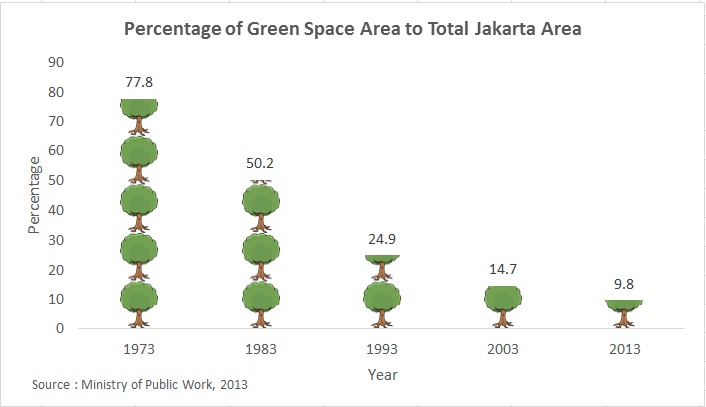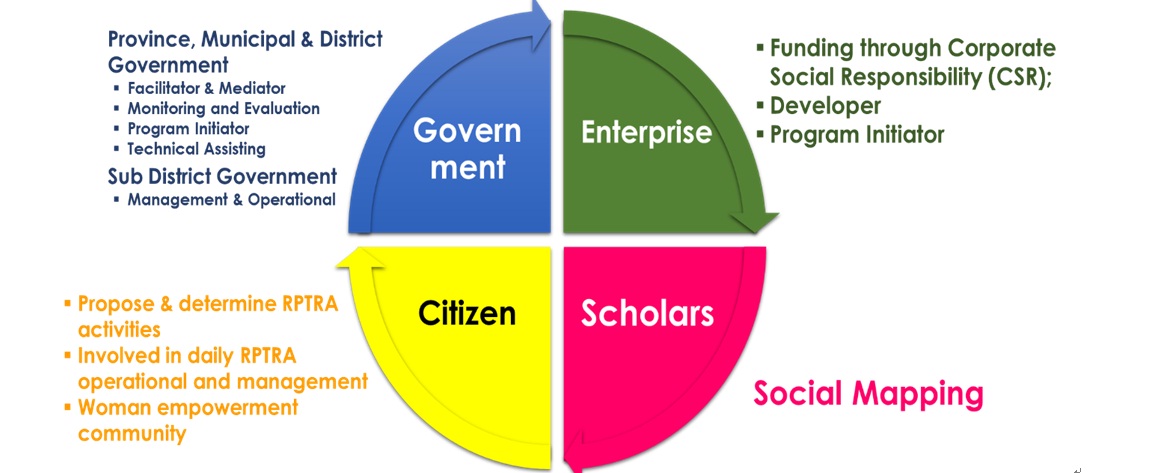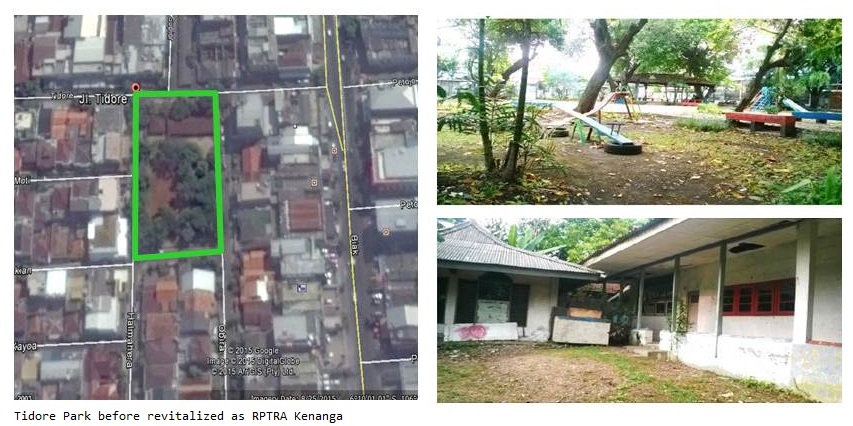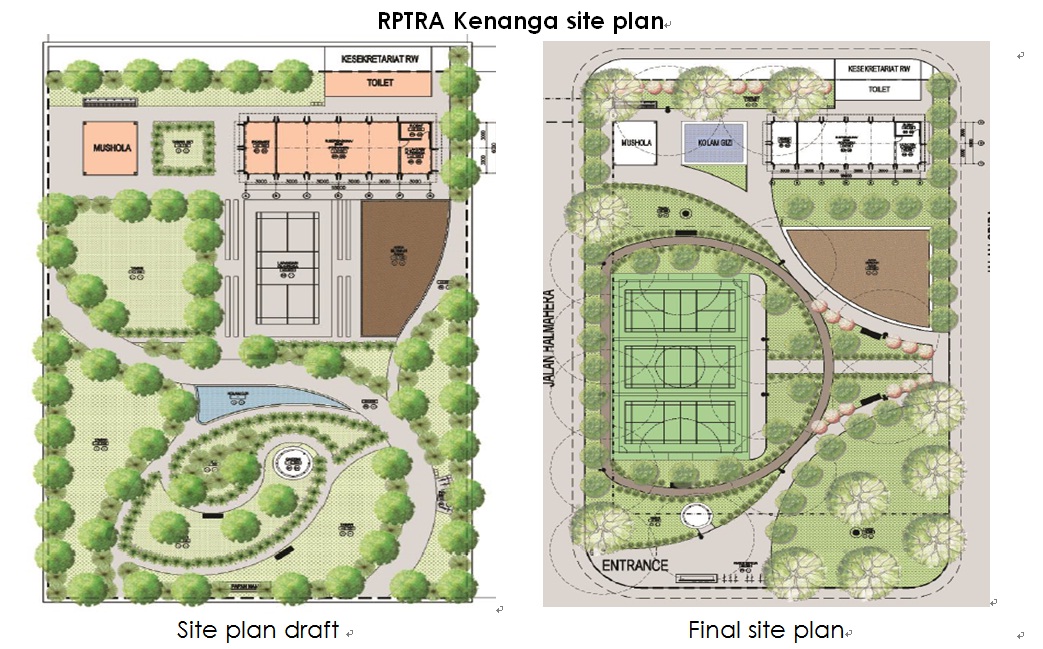RPTRA As A New Image of Jakarta Public Space
Jakarta is the capital city of Indonesia, and listed as 2nd largest megacity by population in the world after Tokyo-Yokohama. In 2014, Jakarta's population is around million people, and its area is 662.3 km2. Like many other big cities, Jakarta, with its large population, encounters many problems : hazardous flooding, poverty, air pollution issues, crime, terrible congestion and lack of public spaces.
Mostly common known of public space is park or any other greenery area. In 2013, Jakarta Capital City Government (JCCG) recorded green space area in Jakarta was only 9.8 % of total Jakarta area or around 64.95 km2. This number had been decreased from 77.8 % of total area in 1973 up to 9,8 % in 2013. These green space include conservation area in Northern and Southern Jakarta and some parks in any scales.
These conditions is aggravated by degradation in quality of existing park especially community parks. Not well-maintained, and changes of usage makes park become uninteresting place and limits its activities and users. Bad management by the government is considered as the main cause.
Mostly common known of public space is park or any other greenery area. In 2013, Jakarta Capital City Government (JCCG) recorded green space area in Jakarta was only 9.8 % of total Jakarta area or around 64.95 km2. This number had been decreased from 77.8 % of total area in 1973 up to 9,8 % in 2013. These green space include conservation area in Northern and Southern Jakarta and some parks in any scales.
These conditions is aggravated by degradation in quality of existing park especially community parks. Not well-maintained, and changes of usage makes park become uninteresting place and limits its activities and users. Bad management by the government is considered as the main cause.

RPTRA (Child Friendly Integrated Public Space)
Concerned about the situation, in early 2015 JCCG published new policy to revitalize some community parks to become multi-uses interactive community park. Idea of interactive community park comes up because city government encounters the lack of public space that can be used as community center and evacuation area for disaster mitigation. Considering those situations, government decides to develop public space that can be used as greenery area but also community center, named as RPTRA (Child Friendly Integrated Public Space). This program is based on government’s commitment to improve citize quality of life, especially chidren; and also reality that playground is very limited, lack of space for citizen social needs. Beside that RPTRA in the future also planned to be utilized as evacuation area.
According to Governer Regulation Number 196 (2015), RPTRA is public space that ulitilized with mixed usage and activities, integrated with the entre Children Friendly City campaign. Jakarta already has this kind of public space, that is interactive park. The difference is, in intervactive park, commonly one single usage and mostly for recreational purpose. Refered to that regulation, RPTRA’s functions are public park; playground to support chidren growth trajectory; water storage; social activity centre; family information and consultation centre; evacuation area; economy activity centre; small scale shop managed by woman empowerment community.
On the initiative stage, RPTRA is developed on existing community park of populated densely area. The reason is, because citizen on this area is susceptible to social problem, such as violence against women and children. This public space is a way of antipation to it. For the development, government engaged with private sector or enterprise through Corporate Social Responsibility (CSR) program for funding this project.
CSR is an obligation of limited companies to Limited Company Act (2007) and Indonesia Government Regulation of Social and Environment Responsibilities (2012). Those regulations obligate every limited companies have to do and make plan for its social and environment responsibilities (budgeted and calculated on company expenditure cost plan). CSR is a company’s sense of responsibility towards the community and environment (both ecological and social) in which it operates. Those activities should give sustainable benefit. The collaboration and responsibilities, between each stake holders, are shown in figure below.

RPTRA Kenanga
The first initiation was RPTRA Kenanga in Cideng Subdistrict, Gambir District, Central Jakarta and launched at May 2015. Kelurahan Cideng area is 1.26 km2. In 2015, its population is 18.890, so the density is 14.490 people/km2 (relatively high).
Previously RPTRA Kenanga was known as Tidore Park with area was 3.266 m2. Tidore Park had physical quality degradation. This degradated quality caused children only can play during daytime. RPTRA Kenanga was funded by Jaya Property Ltd.

On the first site plan draft, main used of RPTRA Kenanga was aimed for greenery and recreation area. After social mapping, the activities on site are more various, such as : mini soccer field, play ground, community centre, urban farming site, community and health service centre, library, pre-school education centre, and women empowerment.

.jpg)
RPTRA shifts public space form from park into multi-used park. This raise some question why the new form is better than the previous one. One of the main cause why Tidore Park is not more good place because the park is dull. The activities there are very limited, so does the people are engaged. The place is not comfortable and can not become sociable place. There is no place to sit or for people to stop by to interact each other. RPTRA can be innovative way to change people perspective about park or public space. There are some benefits that we can gain through this project, such as :
- RPTRA become new image of fun, active and sociable multi-used park
- Coordination between government and enterprise make the RPTRA program implemented efficiently;
- Shift management system, from municipal government to sub-district government, enable better routine maintenance;
- Collaboration with citizen creates sense of belonging to the public space;
- RPTRA becomes basic social needs. This can encourage new public space provision on any other area that has no park or public space.
Eventhough RPTRA come up as improving policy, but some problems are emerging as these followings:
- Social mapping was done without any guidance. This process took long time and created many conflicts among stake holders.
- RPTRA can not be reliable to improve rain water storage management. Jakarta needs bigger greenery area and integrated water storage system to solve flooding issue.
- There is no long-term strategic plan to improve this policy;
- Rely on CSR funding is risky;
- RPTRA is only suitable to built as specific area.
Until end of 2015, JCCG already had built more than 10 RPTRAs. Based on the previous experience, JCCG tries to minimize some emerging problems. Some RPTRAs was built using city budget and more children involvement on the social mapping process.
Although RPTRA policy is not so effective on increasing greenery area, but this policy can be used as an incitement for citizen to propose their local government to implement this concept on their neighbourhoods. Since the main purpose of this policy is to improve citizen quality life and welfare, we may can see the benefit in long term. In next 5 or 10 years, Jakarta may be listed as one of the happiest city in the world.